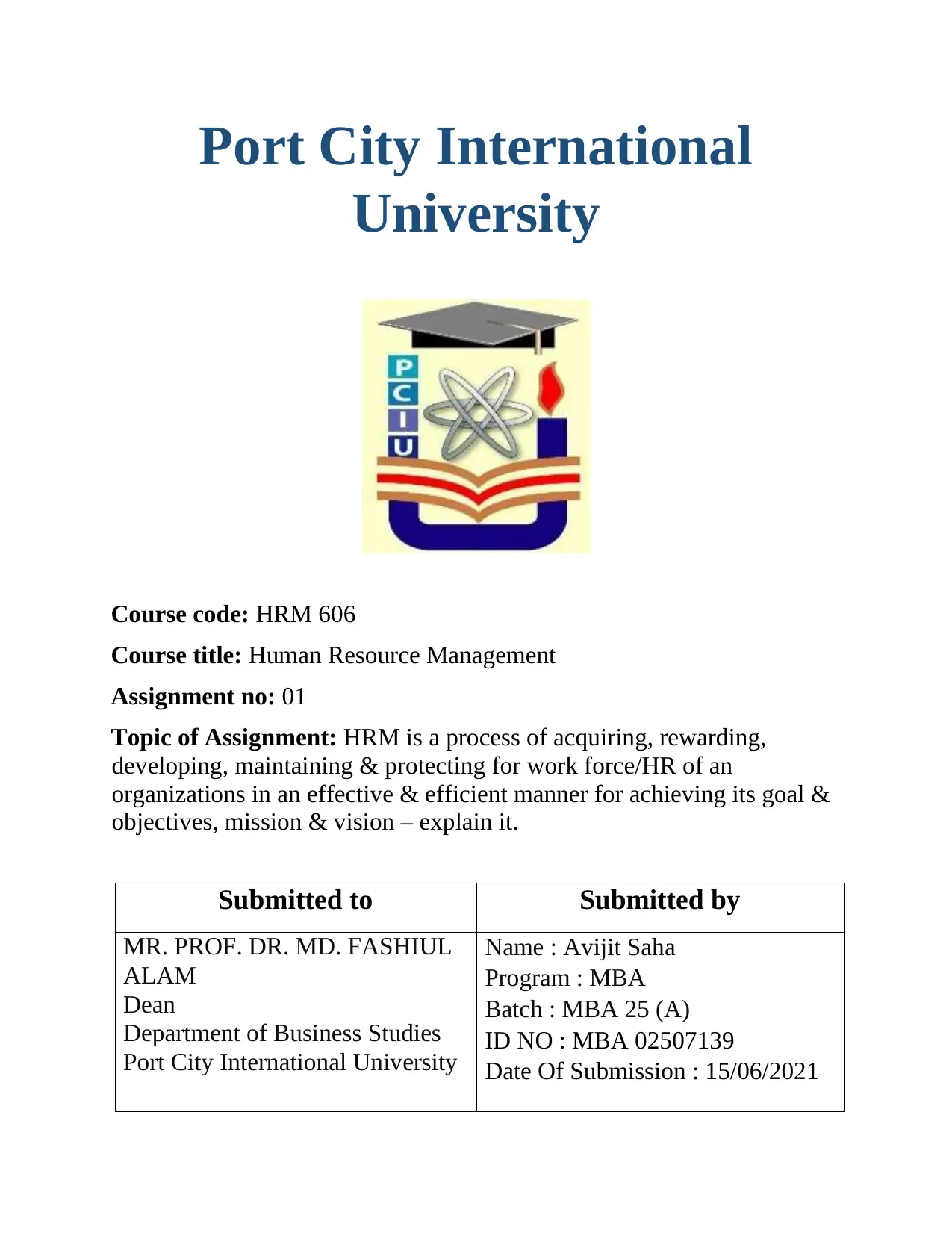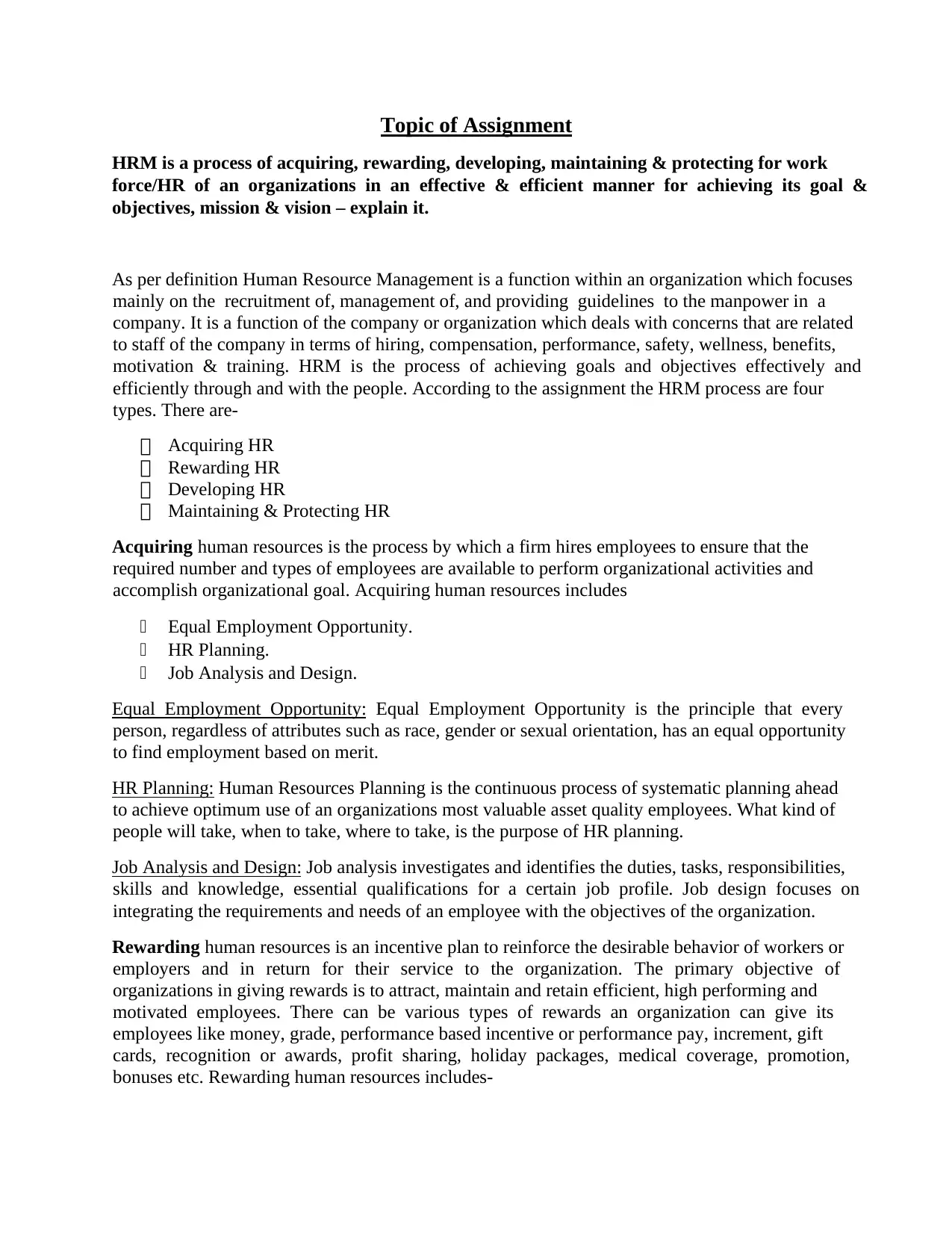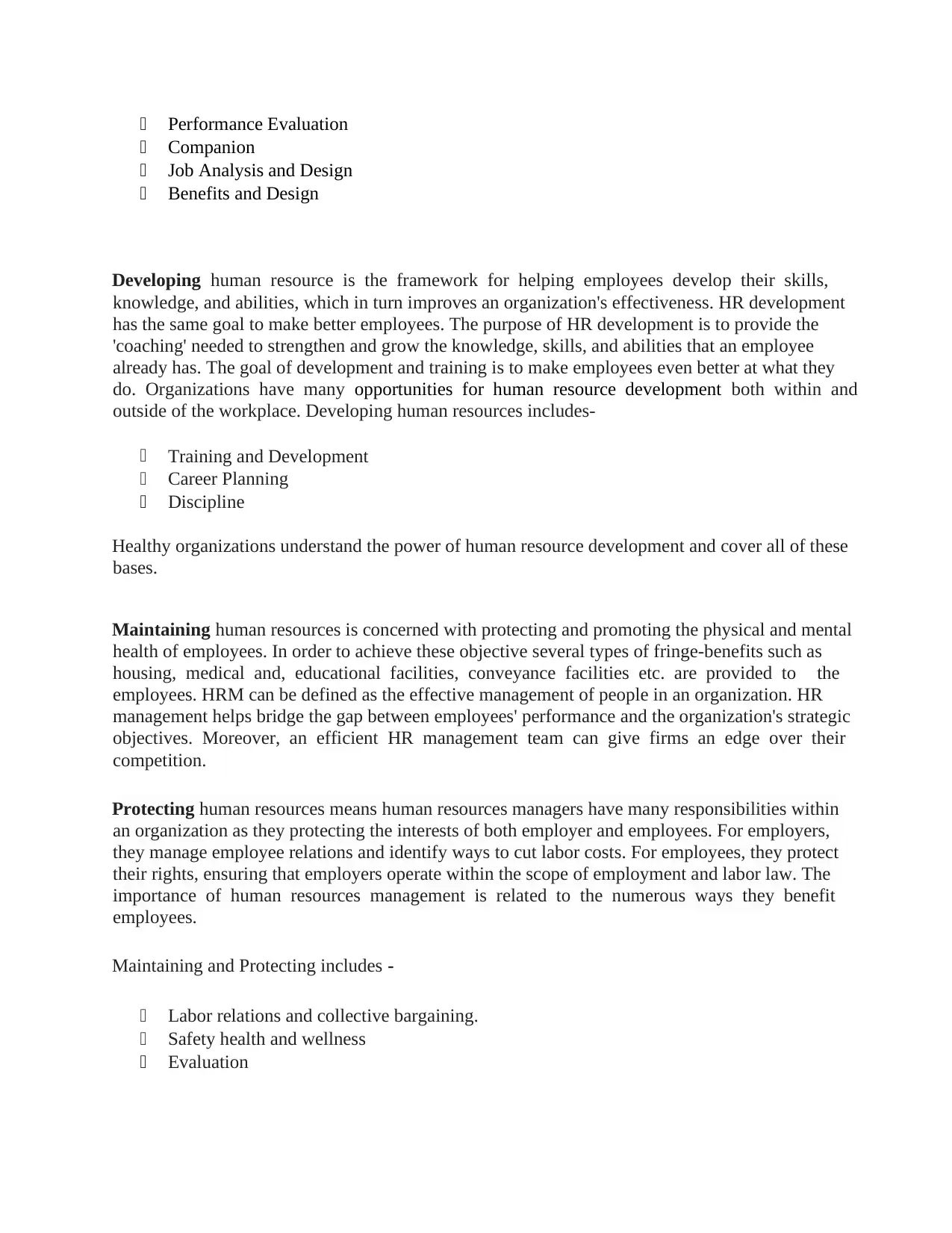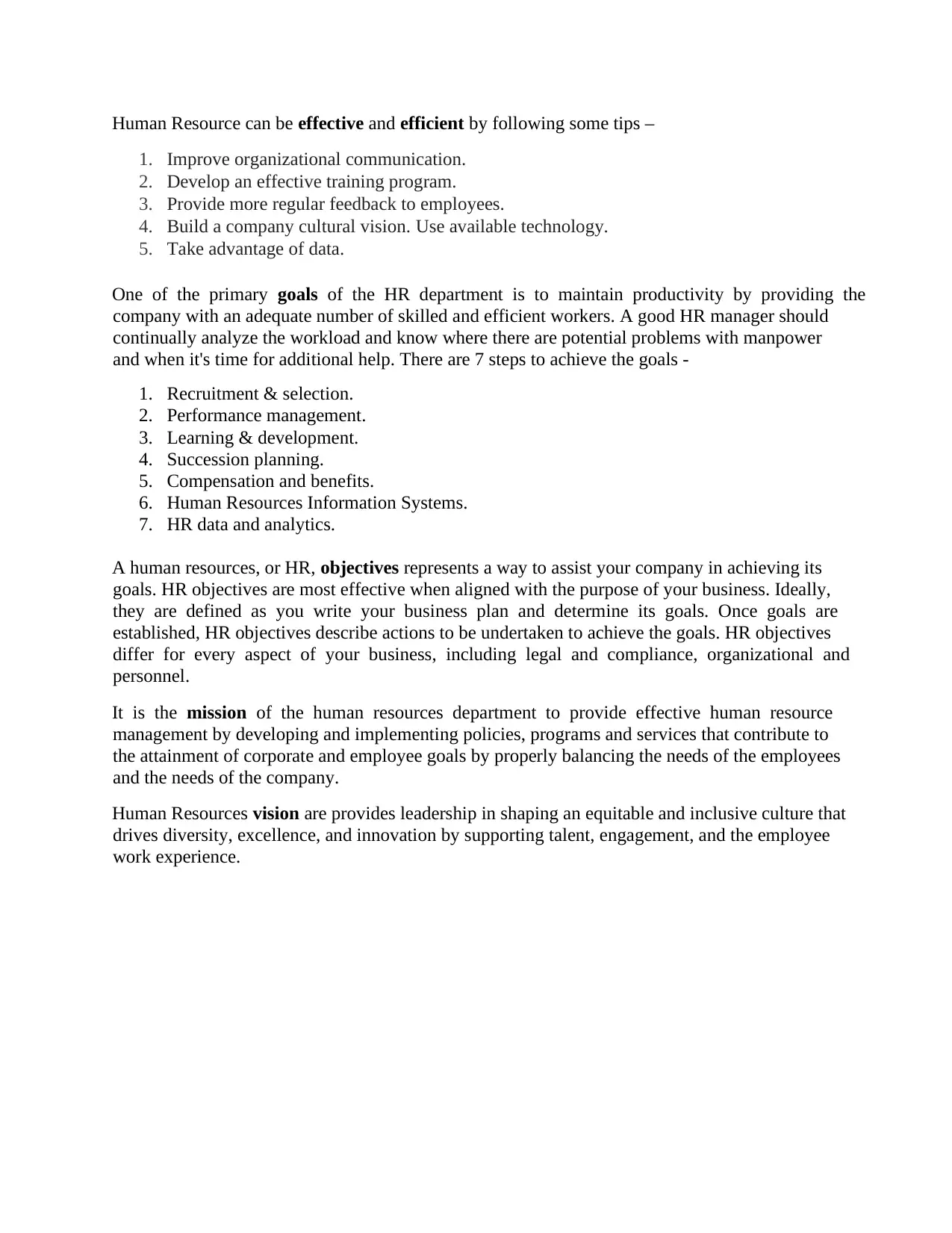Human Resource Management Processes Explained: HRM 606 Assignment
VerifiedAdded on 2021/07/28
|4
|1210
|166
Homework Assignment
AI Summary
This assignment, submitted for HRM 606 at Port City International University, explores the comprehensive process of Human Resource Management (HRM). It defines HRM as the effective and efficient management of an organization's workforce to achieve its goals and objectives. The assignment breaks down the HRM process into four key areas: Acquiring, Rewarding, Developing, and Maintaining human resources, detailing the key elements of each. Acquiring covers equal employment opportunity, HR planning, and job analysis. Rewarding encompasses performance evaluation and benefits. Developing involves training, career planning, and discipline. Maintaining includes labor relations and employee wellness. The assignment also highlights the importance of HR objectives, aligning them with business goals, and outlines steps to achieve these objectives. It emphasizes the role of the HR department in maintaining productivity and fostering a positive work environment through effective communication, training, and use of technology. The document also emphasizes the importance of HR in protecting the interests of both employers and employees.

Port City International
University
Course code: HRM 606
Course title: Human Resource Management
Assignment no: 01
Topic of Assignment: HRM is a process of acquiring, rewarding,
developing, maintaining & protecting for work force/HR of an
organizations in an effective & efficient manner for achieving its goal &
objectives, mission & vision – explain it.
Submitted to Submitted by
MR. PROF. DR. MD. FASHIUL
ALAM
Dean
Department of Business Studies
Port City International University
Name : Avijit Saha
Program : MBA
Batch : MBA 25 (A)
ID NO : MBA 02507139
Date Of Submission : 15/06/2021
University
Course code: HRM 606
Course title: Human Resource Management
Assignment no: 01
Topic of Assignment: HRM is a process of acquiring, rewarding,
developing, maintaining & protecting for work force/HR of an
organizations in an effective & efficient manner for achieving its goal &
objectives, mission & vision – explain it.
Submitted to Submitted by
MR. PROF. DR. MD. FASHIUL
ALAM
Dean
Department of Business Studies
Port City International University
Name : Avijit Saha
Program : MBA
Batch : MBA 25 (A)
ID NO : MBA 02507139
Date Of Submission : 15/06/2021
Paraphrase This Document
Need a fresh take? Get an instant paraphrase of this document with our AI Paraphraser

Topic of Assignment
HRM is a process of acquiring, rewarding, developing, maintaining & protecting for work
force/HR of an organizations in an effective & efficient manner for achieving its goal &
objectives, mission & vision – explain it.
As per definition Human Resource Management is a function within an organization which focuses
mainly on the recruitment of, management of, and providing guidelines to the manpower in a
company. It is a function of the company or organization which deals with concerns that are related
to staff of the company in terms of hiring, compensation, performance, safety, wellness, benefits,
motivation & training. HRM is the process of achieving goals and objectives effectively and
efficiently through and with the people. According to the assignment the HRM process are four
types. There are-
Acquiring HR
Rewarding HR
Developing HR
Maintaining & Protecting HR
Acquiring human resources is the process by which a firm hires employees to ensure that the
required number and types of employees are available to perform organizational activities and
accomplish organizational goal. Acquiring human resources includes
Equal Employment Opportunity.
HR Planning.
Job Analysis and Design.
Equal Employment Opportunity: Equal Employment Opportunity is the principle that every
person, regardless of attributes such as race, gender or sexual orientation, has an equal opportunity
to find employment based on merit.
HR Planning: Human Resources Planning is the continuous process of systematic planning ahead
to achieve optimum use of an organizations most valuable asset quality employees. What kind of
people will take, when to take, where to take, is the purpose of HR planning.
Job Analysis and Design: Job analysis investigates and identifies the duties, tasks, responsibilities,
skills and knowledge, essential qualifications for a certain job profile. Job design focuses on
integrating the requirements and needs of an employee with the objectives of the organization.
Rewarding human resources is an incentive plan to reinforce the desirable behavior of workers or
employers and in return for their service to the organization. The primary objective of
organizations in giving rewards is to attract, maintain and retain efficient, high performing and
motivated employees. There can be various types of rewards an organization can give its
employees like money, grade, performance based incentive or performance pay, increment, gift
cards, recognition or awards, profit sharing, holiday packages, medical coverage, promotion,
bonuses etc. Rewarding human resources includes-
HRM is a process of acquiring, rewarding, developing, maintaining & protecting for work
force/HR of an organizations in an effective & efficient manner for achieving its goal &
objectives, mission & vision – explain it.
As per definition Human Resource Management is a function within an organization which focuses
mainly on the recruitment of, management of, and providing guidelines to the manpower in a
company. It is a function of the company or organization which deals with concerns that are related
to staff of the company in terms of hiring, compensation, performance, safety, wellness, benefits,
motivation & training. HRM is the process of achieving goals and objectives effectively and
efficiently through and with the people. According to the assignment the HRM process are four
types. There are-
Acquiring HR
Rewarding HR
Developing HR
Maintaining & Protecting HR
Acquiring human resources is the process by which a firm hires employees to ensure that the
required number and types of employees are available to perform organizational activities and
accomplish organizational goal. Acquiring human resources includes
Equal Employment Opportunity.
HR Planning.
Job Analysis and Design.
Equal Employment Opportunity: Equal Employment Opportunity is the principle that every
person, regardless of attributes such as race, gender or sexual orientation, has an equal opportunity
to find employment based on merit.
HR Planning: Human Resources Planning is the continuous process of systematic planning ahead
to achieve optimum use of an organizations most valuable asset quality employees. What kind of
people will take, when to take, where to take, is the purpose of HR planning.
Job Analysis and Design: Job analysis investigates and identifies the duties, tasks, responsibilities,
skills and knowledge, essential qualifications for a certain job profile. Job design focuses on
integrating the requirements and needs of an employee with the objectives of the organization.
Rewarding human resources is an incentive plan to reinforce the desirable behavior of workers or
employers and in return for their service to the organization. The primary objective of
organizations in giving rewards is to attract, maintain and retain efficient, high performing and
motivated employees. There can be various types of rewards an organization can give its
employees like money, grade, performance based incentive or performance pay, increment, gift
cards, recognition or awards, profit sharing, holiday packages, medical coverage, promotion,
bonuses etc. Rewarding human resources includes-

Performance Evaluation
Companion
Job Analysis and Design
Benefits and Design
Developing human resource is the framework for helping employees develop their skills,
knowledge, and abilities, which in turn improves an organization's effectiveness. HR development
has the same goal to make better employees. The purpose of HR development is to provide the
'coaching' needed to strengthen and grow the knowledge, skills, and abilities that an employee
already has. The goal of development and training is to make employees even better at what they
do. Organizations have many opportunities for human resource development both within and
outside of the workplace. Developing human resources includes-
Training and Development
Career Planning
Discipline
Healthy organizations understand the power of human resource development and cover all of these
bases.
Maintaining human resources is concerned with protecting and promoting the physical and mental
health of employees. In order to achieve these objective several types of fringe-benefits such as
housing, medical and, educational facilities, conveyance facilities etc. are provided to the
employees. HRM can be defined as the effective management of people in an organization. HR
management helps bridge the gap between employees' performance and the organization's strategic
objectives. Moreover, an efficient HR management team can give firms an edge over their
competition.
Protecting human resources means human resources managers have many responsibilities within
an organization as they protecting the interests of both employer and employees. For employers,
they manage employee relations and identify ways to cut labor costs. For employees, they protect
their rights, ensuring that employers operate within the scope of employment and labor law. The
importance of human resources management is related to the numerous ways they benefit
employees.
Maintaining and Protecting includes -
Labor relations and collective bargaining.
Safety health and wellness
Evaluation
Companion
Job Analysis and Design
Benefits and Design
Developing human resource is the framework for helping employees develop their skills,
knowledge, and abilities, which in turn improves an organization's effectiveness. HR development
has the same goal to make better employees. The purpose of HR development is to provide the
'coaching' needed to strengthen and grow the knowledge, skills, and abilities that an employee
already has. The goal of development and training is to make employees even better at what they
do. Organizations have many opportunities for human resource development both within and
outside of the workplace. Developing human resources includes-
Training and Development
Career Planning
Discipline
Healthy organizations understand the power of human resource development and cover all of these
bases.
Maintaining human resources is concerned with protecting and promoting the physical and mental
health of employees. In order to achieve these objective several types of fringe-benefits such as
housing, medical and, educational facilities, conveyance facilities etc. are provided to the
employees. HRM can be defined as the effective management of people in an organization. HR
management helps bridge the gap between employees' performance and the organization's strategic
objectives. Moreover, an efficient HR management team can give firms an edge over their
competition.
Protecting human resources means human resources managers have many responsibilities within
an organization as they protecting the interests of both employer and employees. For employers,
they manage employee relations and identify ways to cut labor costs. For employees, they protect
their rights, ensuring that employers operate within the scope of employment and labor law. The
importance of human resources management is related to the numerous ways they benefit
employees.
Maintaining and Protecting includes -
Labor relations and collective bargaining.
Safety health and wellness
Evaluation
⊘ This is a preview!⊘
Do you want full access?
Subscribe today to unlock all pages.

Trusted by 1+ million students worldwide

Human Resource can be effective and efficient by following some tips –
1. Improve organizational communication.
2. Develop an effective training program.
3. Provide more regular feedback to employees.
4. Build a company cultural vision. Use available technology.
5. Take advantage of data.
One of the primary goals of the HR department is to maintain productivity by providing the
company with an adequate number of skilled and efficient workers. A good HR manager should
continually analyze the workload and know where there are potential problems with manpower
and when it's time for additional help. There are 7 steps to achieve the goals -
1. Recruitment & selection.
2. Performance management.
3. Learning & development.
4. Succession planning.
5. Compensation and benefits.
6. Human Resources Information Systems.
7. HR data and analytics.
A human resources, or HR, objectives represents a way to assist your company in achieving its
goals. HR objectives are most effective when aligned with the purpose of your business. Ideally,
they are defined as you write your business plan and determine its goals. Once goals are
established, HR objectives describe actions to be undertaken to achieve the goals. HR objectives
differ for every aspect of your business, including legal and compliance, organizational and
personnel.
It is the mission of the human resources department to provide effective human resource
management by developing and implementing policies, programs and services that contribute to
the attainment of corporate and employee goals by properly balancing the needs of the employees
and the needs of the company.
Human Resources vision are provides leadership in shaping an equitable and inclusive culture that
drives diversity, excellence, and innovation by supporting talent, engagement, and the employee
work experience.
1. Improve organizational communication.
2. Develop an effective training program.
3. Provide more regular feedback to employees.
4. Build a company cultural vision. Use available technology.
5. Take advantage of data.
One of the primary goals of the HR department is to maintain productivity by providing the
company with an adequate number of skilled and efficient workers. A good HR manager should
continually analyze the workload and know where there are potential problems with manpower
and when it's time for additional help. There are 7 steps to achieve the goals -
1. Recruitment & selection.
2. Performance management.
3. Learning & development.
4. Succession planning.
5. Compensation and benefits.
6. Human Resources Information Systems.
7. HR data and analytics.
A human resources, or HR, objectives represents a way to assist your company in achieving its
goals. HR objectives are most effective when aligned with the purpose of your business. Ideally,
they are defined as you write your business plan and determine its goals. Once goals are
established, HR objectives describe actions to be undertaken to achieve the goals. HR objectives
differ for every aspect of your business, including legal and compliance, organizational and
personnel.
It is the mission of the human resources department to provide effective human resource
management by developing and implementing policies, programs and services that contribute to
the attainment of corporate and employee goals by properly balancing the needs of the employees
and the needs of the company.
Human Resources vision are provides leadership in shaping an equitable and inclusive culture that
drives diversity, excellence, and innovation by supporting talent, engagement, and the employee
work experience.
1 out of 4
Related Documents
Your All-in-One AI-Powered Toolkit for Academic Success.
+13062052269
info@desklib.com
Available 24*7 on WhatsApp / Email
![[object Object]](/_next/static/media/star-bottom.7253800d.svg)
Unlock your academic potential
Copyright © 2020–2025 A2Z Services. All Rights Reserved. Developed and managed by ZUCOL.





